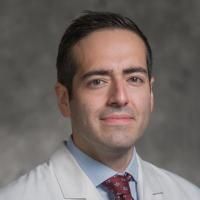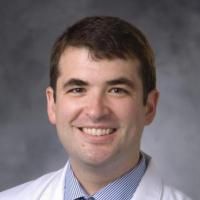The Eyes Have It-for Idiopathic Pulmonary Fibrosis: a Preliminary Observation.
Date
2022-09
Journal Title
Journal ISSN
Volume Title
Repository Usage Stats
views
downloads
Citation Stats
Abstract
Introduction
The disease origins of idiopathic pulmonary fibrosis (IPF), which occurs at higher rates in certain races/ethnicities, are not understood. The highest rates occur in white persons of European descent, particularly those with light skin, who are also susceptible to lysosomal organelle dysfunction of the skin leading to fibroproliferative disease . We had observed clinically that the vast majority of patients with IPF had light-colored eyes, suggesting a phenotypic characteristic.Methods
We pursued this observation through a research database from the USA Veterans Administration, a population that has a high occurrence of IPF due to predominance of elderly male smokers. Using this medical records database, which included facial photos, we compared the frequency of light (blue, green, hazel) and dark (light brown, brown) eyes among white patients diagnosed with IPF compared with a control group of lung granuloma only (no other radiologic evidence of interstitial lung disease).Results
Light eye color was significantly more prevalent in patients with IPF than in the control group with lung granuloma [114/147 (77.6%) versus 129/263 (49.0%], p < 0.001), indicating that light-colored eyes are a phenotype associated with IPF .Conclusion
We provide evidence that light eye color is predominant among white persons with IPF.Type
Department
Description
Provenance
Citation
Permalink
Published Version (Please cite this version)
Publication Info
Pleasants, Roy A, Armando D Bedoya, Joel M Boggan, Karen Welty-Wolf and Robert M Tighe (2022). The Eyes Have It-for Idiopathic Pulmonary Fibrosis: a Preliminary Observation. Pulmonary therapy, 8(3). pp. 327–331. 10.1007/s41030-022-00198-5 Retrieved from https://hdl.handle.net/10161/26626.
This is constructed from limited available data and may be imprecise. To cite this article, please review & use the official citation provided by the journal.
Collections
Scholars@Duke

Armando Diego Bedoya

Joel Boggan
I am a hospital medicine physician interested in quality improvement, patient safety, and medical education across the UME, GME, and CME environments. My current QI and research projects include work on readmissions, inpatient ORYX and patient experience measures, clinical documentation improvement, medication reconciliation, and appropriate utilization of inpatient resources. Alongside this work, I serve as the lead mentor for our Durham VA Chief Resident in Quality and Safety within the Department of Medicine and the Program Director for the Duke University Hospital CRQS.
As Associate Program Director for Quality Improvement and Patient Safety in the Duke Internal Medicine Residency Program, I oversee QI and safety education and projects for our residents and help co-lead our Residency Patient Safety and Quality Council. Additionally, I supervise housestaff and students on our general medicine wards, precept housestaff evidence-based medicine resident reports, and serve as a small group leader for our second-year medical student Clinical Skills Course. Finally, I lead our Innovation Sciences committee as part of the ongoing School of Medicine Curriculum Innovation Initiative.

Karen Elizabeth Welty-Wolf
Dr. Welty-Wolf studies (1) pathophysiology and treatment of acute lung injury and (2) multiple organ failure and disordered energy metabolism in sepsis. Injury models include hyperoxic lung injury and ARDS with multiple organ failure due to sepsis. In addition to evaluating mechanisms of lung injury in sepsis, current studies are being conducted to evaluate the potential role of monoclinal antibodies to neutrophil adhesion molecules in the prevention of this injury. Other sepsis work includes evaluating mechanisms of oxidative damage to mitochondria. Additional research efforts include evaluating the use of human recombinant manganese superoxide dismutase in preventing hyperoxic lung injury.

Robert Matthew Tighe
The research focus of the Tighe laboratory is performing pulmonary basic-translational studies to define mechanisms of susceptibility to lung injury and disease. There are three principal focus areas. These include: 1) Identifying susceptibility factors and candidate pathways relevant to host biological responses to environmental pollutants such as ozone, woodsmoke and silica, 2) Defining protective and detrimental functions of lung macrophage subsets and their cross talk with the epithelium to regulate lung injury and repair, and 3) Determining the prognostic and theragnostic efficacy of 3D lung gas exchange imaging in pulmonary fibrosis using hyperpolarized 129Xenon MRI.
-
Susceptibility Factors for Environmental Lung Disease: In NIH funded studies the Tighe lab has been performing fully translational studies of lung responses to ozone. These include cell, rodent and human exposure studies to define mechanisms of susceptibility to exposure. By carefully dissecting these links, we will gain insight into how environmental pollutants acutely induce respiratory symptoms and exacerbate chronic lung diseases. This can lead to targeted therapeutics and/or identify susceptible populations. This includes exploration of genetic factors and also other metabolic and immunologic factors.
-
Pulmonary Macrophage Functions and Crosstalk with Lung Epithelial Cells: The central hypothesis of this line of research is that macrophages are key regulators of the biologic responses to environmental pollutants and the development of chronic lung disease. The Tighe laboratory has pioneered the identification of novel pulmonary macrophage subsets and has defined their function in lung injury and repair. In both published work and areas of active investigation, the Tighe lab has identified macrophage subsets with unique genetic programming and function after challenges with environmental exposures such as ozone, wood smoke and silica. Since macrophages have both detrimental and protective functions, identifying these subsets offers the opportunity to understand their unique programing and function. This could allow development of targeted therapeutics that take advantage of these functions, polarize the immune responses and alleviate respiratory disease. In addition, we are focused on macrophage and epithelial crosstalk and how their combined responses regulate lung injury and repair. These studies include omics approaches with single-cell RNA sequencing, proteomics and metabolomics and lung organoids to identify unique signals between macrophages and epithelial cells.
-
Using Hyperpolarized 129Xenon MRI to Define Prognosis and Therapy Responses in Pulmonary Fibrosis: In industry funded studies, the Tighe lab is focused on using a novel image modality to assess prognosis and therapeutic responses in individuals with pulmonary fibrosis. Pulmonary fibrosis is a disorder of progressive scar formation in the lung that causes increased shortness of breath and persistent coughing, frequently leading to death from respiratory failure. Presently, there are limited modalities that can assess prognosis in pulmonary fibrosis and can determine which individuals are responding to therapies. To address this, the Tighe lab, in collaboration with Dr. Bastiaan Driehuys in the Department of Radiology, is using inhaled hyperpolarized 129Xenon gas MRI to define regional differences in lung gas exchange in individuals with pulmonary fibrosis. Our preliminary data suggest that baseline characteristics of 129Xenon MRI associate with pulmonary fibrosis prognosis. In addition, we observe changes in the 129Xenon MRI metrics following initiation of pulmonary fibrosis therapies. These initial observations are being confirmed in ongoing clinical trials.
Unless otherwise indicated, scholarly articles published by Duke faculty members are made available here with a CC-BY-NC (Creative Commons Attribution Non-Commercial) license, as enabled by the Duke Open Access Policy. If you wish to use the materials in ways not already permitted under CC-BY-NC, please consult the copyright owner. Other materials are made available here through the author’s grant of a non-exclusive license to make their work openly accessible.
